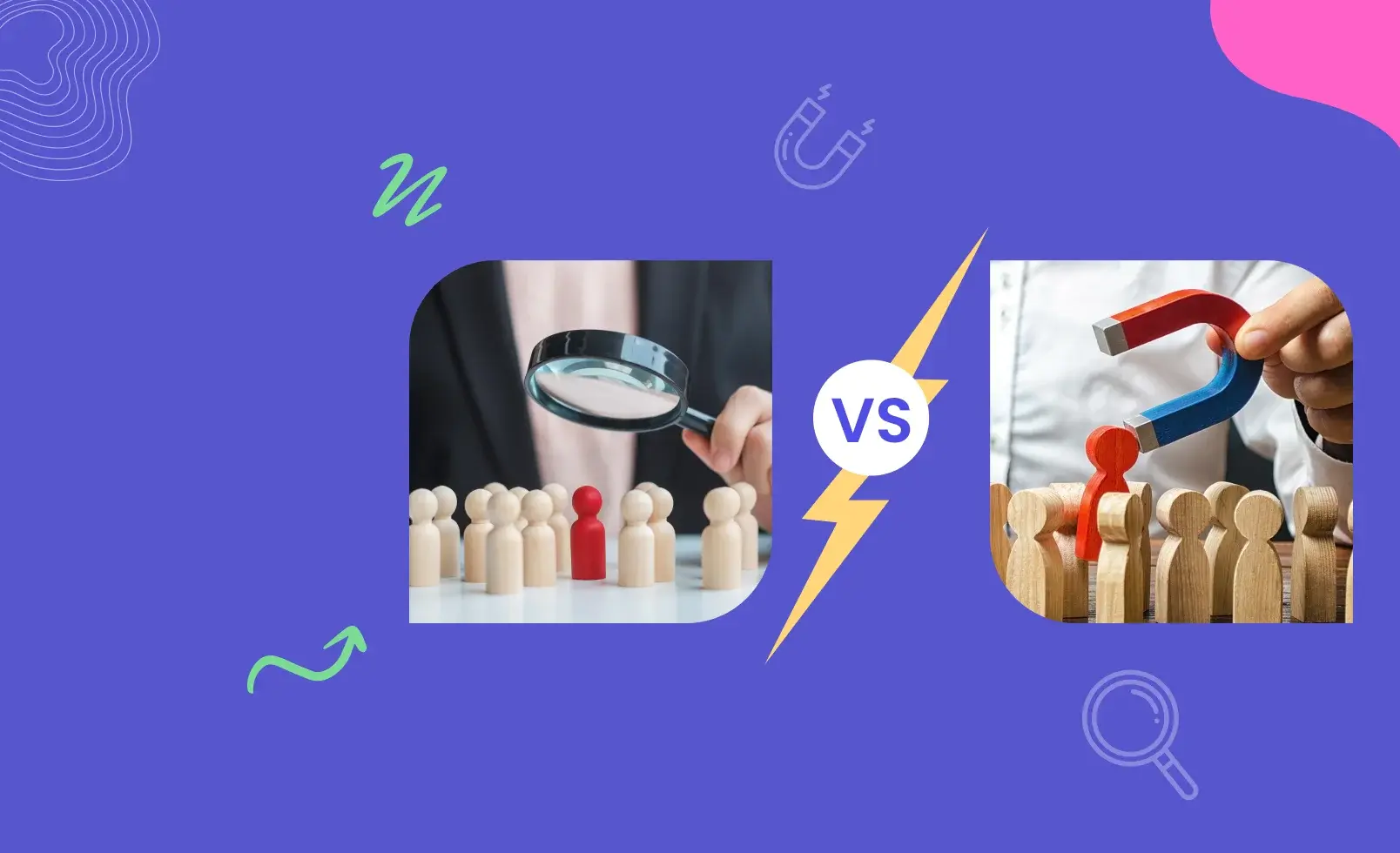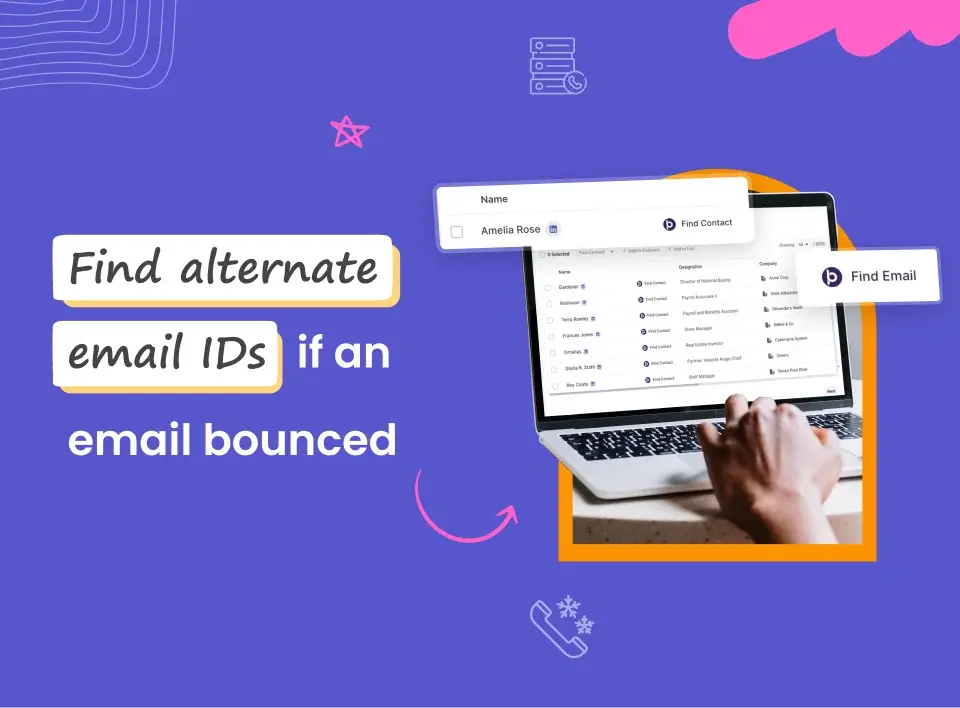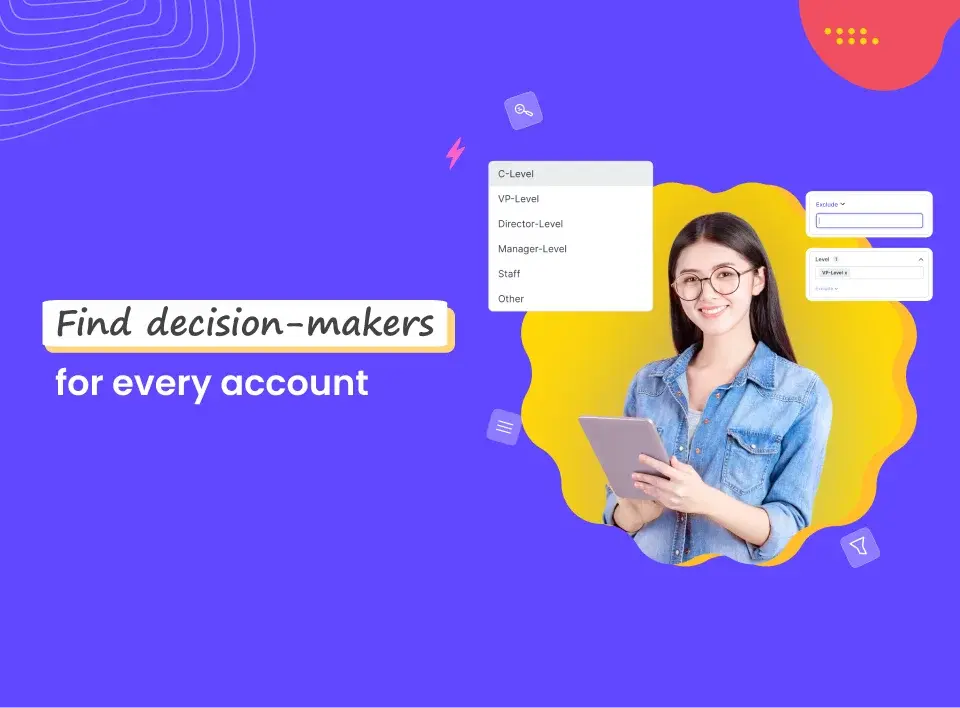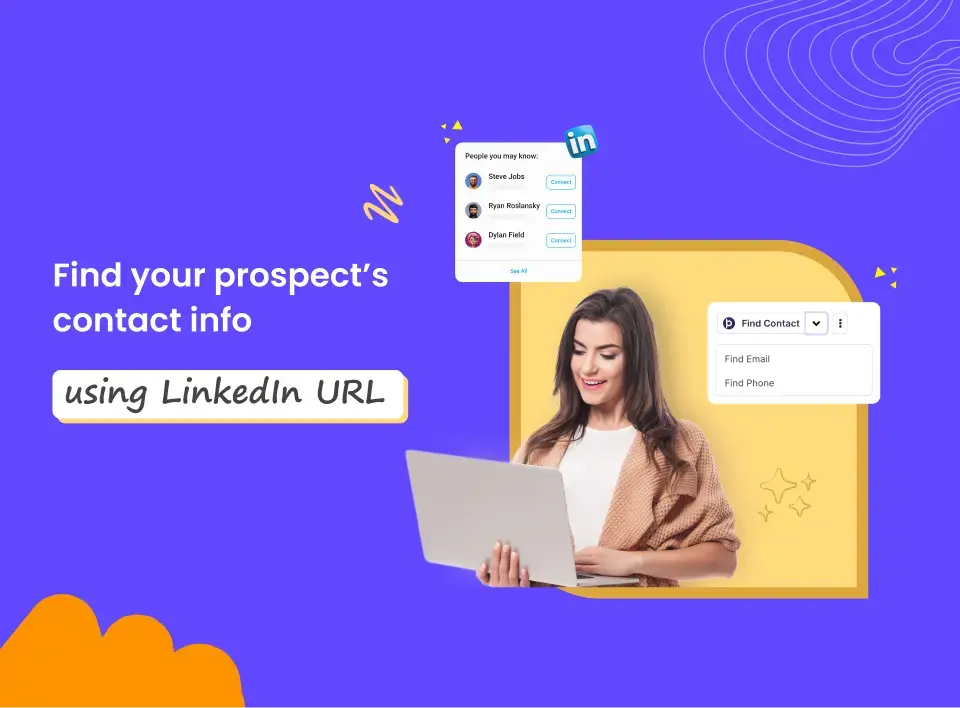Prospecting and lead generation are often used interchangeably. But they’re not the same.
Prospecting is when salespeople actually get in touch with a prospect, whereas lead generation occurs much earlier when website visitors express interest in your solution.
Still confused? Fret not: you’ve come to the right place.
To understand prospecting vs. lead generation, you need first to know who leads and prospects are.
A lead is an individual who has shown interest in your product or service, most likely by downloading content or submitting a form.
A prospect, on the other hand, is a qualified lead. It’s someone who has been further assessed by sales and determined to have potential and interest in becoming a customer. A prospect usually has to meet certain criteria that make them more likely to engage in a sales process.
Now that that’s clear, let’s dive into what is lead generation and prospecting.
What Is Prospecting and Lead Generation?
Just as leads and prospects are in different stages of the buying journey, prospecting and lead generation occur at different stages of the entire sales process.
Let’s understand them a little better.
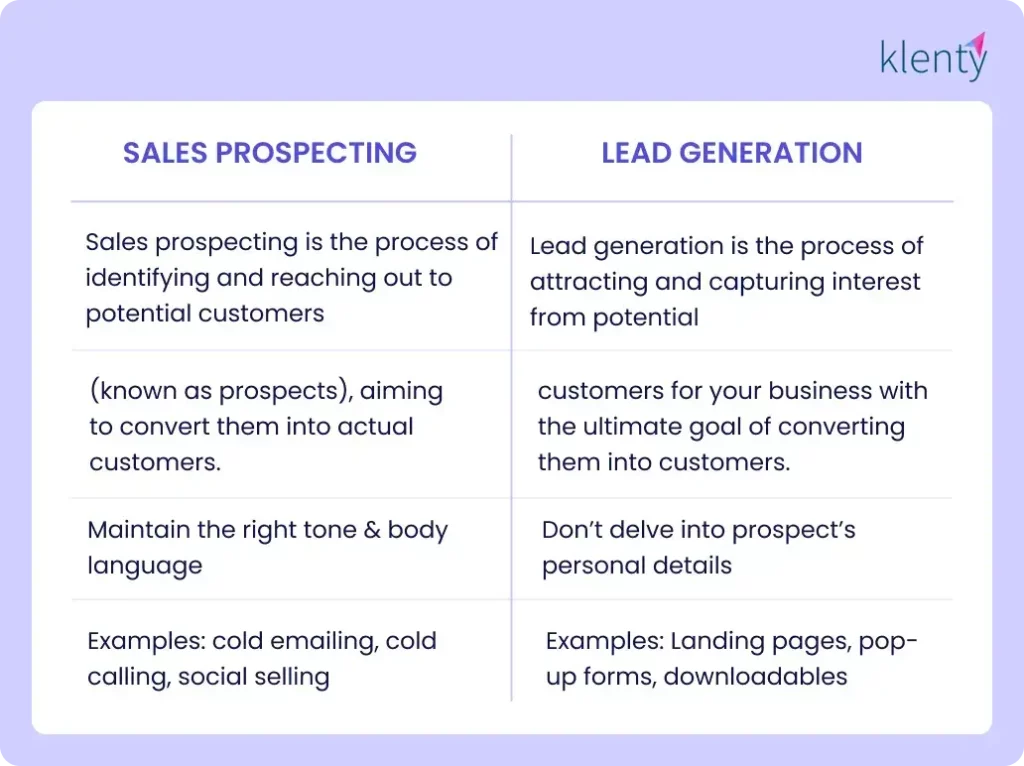
Sales Prospecting
Sales prospecting is the process of identifying and reaching out to potential customers (known as prospects), aiming to convert them into actual customers. It’s the first thing sales teams do while executing an outbound strategy—involving researching, contacting, and qualifying prospects to determine whether or not they could be paying customers.
Sales teams build an effective sales prospecting list by finding potential customers through online research, social media, industry events, networking summits, referrals, and sales prospecting software.
They then contact them via emails, cold calls, or social media using personalized messages to spark interest.
Sales Prospecting Examples
Here are some ways you can reach out to prospects:
- Cold Emailing: Compile a list of your ICPs and hit their inboxes with attention-grabbing yet informative emails.
- Cold Calling: Call your prospects and qualify them based on their purchase intent, buying authority, and budget availability. Set up a meeting to discuss your partnership further.
- Social Selling: Open a conversation on LinkedIn to build a personal relationship with your prospect.
Lead Generation
Lead generation is the process of attracting and capturing interest from potential customers for your business with the ultimate goal of converting them into customers.
Wait… isn’t that what prospecting is all about?
Yes…and no. There’s one key difference between lead generation and prospecting—lead generation focuses on creating awareness, generating interest, and gathering basic contact information through marketing efforts while prospecting occurs further down the sales funnel and is a more active, outbound process.
Lead Generation Examples
Some ways to generate leads:
- Landing Pages: Create comprehensive landing pages detailing your product offerings to excite and inform users. With carefully placed calls-to-action (CTAs), guide them to book a demo or sign up for a free trial.
- Pop-up Forms: When visitors spend longer than average on your website, showcase a form nudging them to sign up.
- Downloadables Resources: Downloads show higher intent than just an average website visitor. Get their contact information and reach out to them when their intent is piping hot! (more on this later)
So, are prospecting and lead generation the same? Short answer: no. Although they may share some similar functionalities, they serve completely different purposes and are both crucial for the growth of your organization.
What Is the Difference Between Prospecting and Lead Generation?
You have a clear idea of how prospecting and lead generation differ from each other but just to sum it up, here’s a comprehensive comparison.
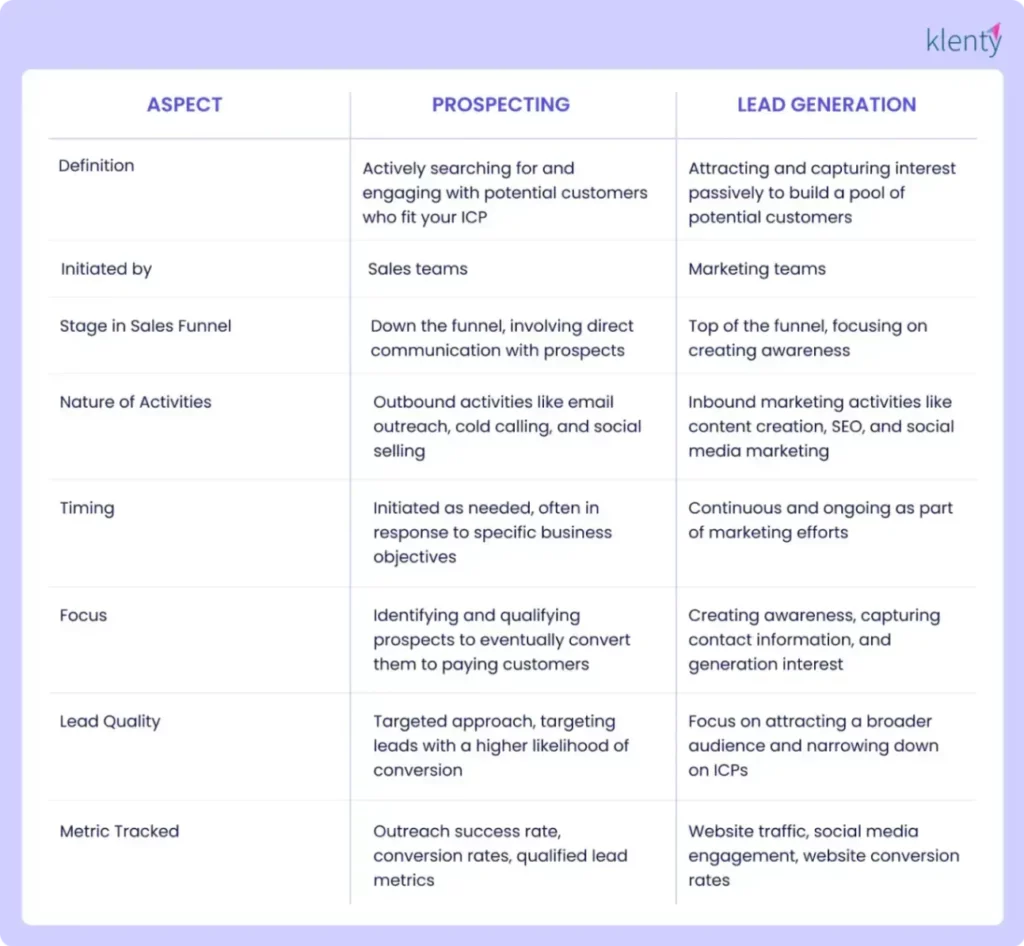
Executing Process: Prospecting and Lead Generation
Like everything else in a B2B organization, lead generation and prospecting require clear planning and execution. Without a strategy in place, chaos ensues, and tracking their effectiveness is almost impossible.
Sales Prospecting Process
Now, how do you identify which buyer persona fits your business well? And how do you make sure you get through to them and convince them to try your product or service?
Let’s see how.
Define Your Audience
First, define your ideal customer profile (ICP), which is a blueprint of your ideal customer. This depends on your business model, but roughly an ICP for a B2B organization should include details like:
- Industry
- Company Size
- Decision-makers
- Pain points faced by prospective customers
- Revenue
These are some basic details about your target audience. However, your ICP must be more nuanced than this and should cater to your business offerings and goals.
Find and Collect Prospect Information
Next, you need to find prospects that fit your ICP.
Sales teams scour the internet for potential customers. Since everyone who is anyone can be found on social media platforms, social selling is one of the most effective sales prospecting strategies. Reps research and contact prospects on LinkedIn, X (previously Twitter), Facebook, and Reddit.
Other methods include leveraging sales prospecting tools that generate your ideal list with the help of filters and sorting.
We recommend you store this information in your CRM for easy access and streamlined sales outreach.
Prepare Your Outbound Strategy
You’ll likely be reaching out to more than one kind of persona. For example, if you’re selling a platform that automates billing, your primary target persona is the Chief Finance Officer, but your secondary preference could be finance teams. So, group them accordingly.
Create separate sales strategies for these groups, with personalized outreach catering to each group’s needs and pains.
Reach Out To Prospects Consistently
Set your outbound plans in motion by adding these lists to relevant sequences. Contact your prospects via email, cold calling, or social media – wherever they’re most active – and don’t forget to follow up regularly.
Then, divide your prospects into groups based on their engagement levels. Prepare different follow-up strategies for prospects who respond and prospects who only read your emails.
Nurture them with educational content like blogs, product explainer videos, and webinars. Persistence is vital when it comes to following up.
Lead Generation Process
How will you know that a lead has shown interest in your solution? Your prospects can find you on various platforms: social media, your company website, and review sites. Here are a few strategies to attract them to your website and gently nudge them to convert:
Develop A Solid Content Marketing Plan
Understand the needs and wants of your target audience and generate high-quality, relevant articles to address these points. Your content strategy can take many shapes and forms—blogs, articles, ebooks, infographics, and videos.
But they’re only useful when they reach your intended audience. So, your next step would be to create a clear and precise content distribution strategy that puts your content right in front of your prospects. You can leverage social media, email marketing, newsletters, and your company website to do so. For example, if your website has a dedicated feature page, display all related content regarding that feature at the bottom of the page.
At Klenty, we have a dedicated “Related Resources” section that highlights all relevant articles.
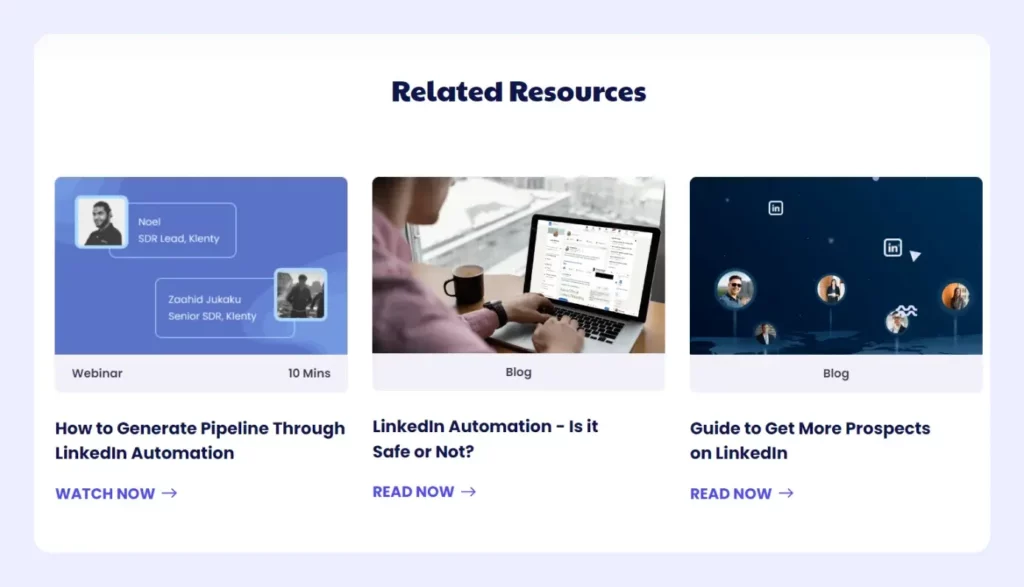
(Source)
Coupled with Search Engine Optimization (SEO), relevant keyword research can help your content rank higher in search engine results. Understand what terms your target audience is searching for, and create content that aligns with those queries. SEO strengthens your online visibility and attracts organic traffic from visitors on the quest for information related to your solution. if you don't have experience or expertise you can ever hire a marketing company for small business that can guide you to optimise your content and improve your brand reputation.
Create a Lead Magnet
A lead magnet is essentially an incentive or offer businesses provide to promising prospects in exchange for contact information. Have you ever registered? And did you have to provide your name and email address at the very least to get an invite? Well, that’s a lead magnet right there.
They can be webinars, ebooks, free tools, templates, cheat sheets, whitepapers, statistical reports, and free trials.
Creating the right lead magnet is a surefire way to attract visitors who are a good fit for your business.
The devil lies in the details, as always. How to make sure it reaches the relevant audience? Well, for starters, be thorough in your prospect’s pain points. Then, generate a lead magnet with them in mind.
Analyze your website traffic to determine your most visited pages, and display the lead magnets to ensure maximum visibility.
Email Marketing Campaigns
What will you do with the information collected through lead magnets? Add them to an email marketing campaign!
Segment your email list based on the lead magnet they opted for, and write a series of relevant emails. Focus on the pain points first and slowly and steadily segue into how your solution can remedy them.
Email marketing is an effective way to maintain regular communication with potential customers and guide them through the sales funnel.
Challenges and Benefits: Prospecting vs Lead Generation
Having discussed the application, a few examples, and their differences, we’ve fully covered what prospecting and lead generation mean to sales and marketing.
As with any endeavor, understanding the challenges and benefits can prepare you for potential setbacks and help you streamline your strategy better.
Sales Prospecting
Let’s explore some challenges and benefits of sales prospecting.
Challenges
- Manual outreach: Sales teams are crippled by manual tasks like admin work and writing emails one by one before sending them. Using sales engagement platforms like Klenty automates mundane tasks and helps teams reach out to prospects consistently.
- Rejections and objections: Sales reps face more rejections than acceptances during outbound outreach. Dealing with them requires resilience and effective objection-handling skills that get better with practice. So, don’t get discouraged!
- Competition: The competitive landscape can be fierce. With lots of competition showing up on calls, you may lose quite a bit of leads to them. It’s all part and parcel of a sales process, but you must work with marketing to figure out your differentiation and prepare relevant collateral to back your claims.
Benefits
- Building a sales pipeline: Prospecting fills your pipeline with a steady flow of potential leads, setting your sales team up for success with an extensive list of prospects to work with.
- Establishing relationships: Good prospecting always leads to the creation of great relationships between you and your prospect early on in the sales process. With this comes trust and familiarity, increasing the likelihood of your prospect actually making a purchase.
- Increased sales opportunities: The more prospects identified and engaged, the higher the chances of finding customers who genuinely need and are interested in the offered products or services.
- Business growth: Sales prospects contribute directly to your business growth by bringing in quality prospects, expanding the user base, and surging revenue opportunities.
Lead Generation
Lead generation has its own set of challenges and benefits.
Challenges
- Balancing quality and quantity of leads: Since marketing can’t control who visits your website, avoiding junk leads is difficult. An excess of low-quality leads may result in wasted time and resources.
- Adapting to changing algorithms: Google changes its algorithm like changing clothes. So, it’s challenging always to be up-to-date. Changes in search engine algorithms and social media algorithms can impact the visibility of content, affecting lead generation strategies.
- Long sales cycles: In industries that typically have longer sales cycles, maintaining the leads’ interest and engagement over an extended period of time is tedious.
- Information overload for users: With a plethora of information available on the internet, leads may feel bogged down and overwhelmed. Having to create new and exciting content that stands out in the crowd can give your brain quite the tease.
Benefits
- Capture leads that are most likely to convert: In inbound marketing, leads come looking for you—highlighting the highest form of intent. Sales can jump at the chance and quickly close the deal through personalized emails or messages.
- Increased brand visibility: The more relevant you are, the more likely your prospects will remember and trust you. And when they trust a brand, they are more likely to purchase. Dory once said, “Just keep swimming.” Well, we say, “Just keep posting (relevant and relatable content, of course!)”.
- Reduced sales cycles: On the flip side, industries with typically shorter sales cycles have a high chance of closing inbound leads sooner. Since these leads are already familiar with your product and offerings, sales just have to play their cards right and return with a royal flush.
What Should You Choose: Prospecting or Lead Generation?
Well, it’s not as simple as that. The decision has to be made at the C-suite level, taking into consideration your business goals, pipeline value, stage of growth, and overall go-to-market strategy.
But it boils down to this: time.
If your pipeline looks empty, pick prospecting. It’s quicker than lead generation and can help book meetings with potential customers sooner.
Industries facing complex sales cycles also benefit from prospecting as it offers a more hands-on approach and more face time with sales to ensure prospects’ needs are being met at the right time.
On the contrary, lead generation takes a while. So, it’s best suited when you’re trying to reach a broader audience and generate a large volume of leads. It’s scalable and efficient.
Unlike sales prospecting, where you target a niche audience, lead generation helps cast a wider net and capture the attention of a wider audience of potential buyers.
How Do Prospecting and Lead Generation Work Together in Sales?
Marketing brings in hot leads for sales. These are people who have shown interest in your product or service by interacting on the website. Interactions include but are not limited to, downloading an ebook, registering for a webinar, or booking a demo.
This is where lead generation ends and prospecting begins.
Once sales receives this list, they start researching the prospect to see if they fit the ICP, what their immediate needs are, and if there are other people within the same company they could reach out to as well.
Then, they contact them via email, call, social media or other relevant channels with highly personalized messaging.
Let’s look at an example.
Stella visits your website and watches a webinar. Now, you collect her name, email address, contact number, and company name through the opt-in form.
When you look it up, Stella fits your ICP to the T.
You now send this lead over to sales, and they immediately contact her, referring to the webinar she just watched.
A few weeks and conversations later, she’s now a happy customer.
We know, we know! This is an oversimplified, ideal version of how things play out. In the real world, it’s much more complicated and involves clever planning and strategizing.
But the fact remains: business growth potential increases tremendously when sales and marketing align their prospecting and lead generation efforts. And there’s data to prove this:
- According to LinkedIn’s study, 87% of sales and marketing leaders agree that collaboration between the two teams is crucial for business growth.
- Businesses with strong sales and marketing alignment are 67% more likely to close deals.
- A study conducted by Gartner reveals that 23% of salespeople say that the misalignment between sales and marketing affects win rates, whereas 20% agree that it affects customer journeys.
Elevate Your Lead Generation and Prospecting With The Right Platform
It’s no secret that lead generation and prospecting form the heartbeat of a business.
While manually prospecting and generating outbound leads is a good practice, it wastes time and resources and results in inaccurate/incomplete data collection and insufficient information on company stakeholders.
After painstakingly building a prospect list, having low connect rates or high email bounces is a devastating blow.
Luckily, Prospect IQ by Klenty nips this problem in the bud.
Prospect IQ is a B2B prospecting data platform that has over 440M+ contacts and helps you:
- Filter prospects based on company name, industry, department, revenue size, technologies used, domain name, and so on
- Save your “ICP” or “Best Customer Lookalikes” as Views that can be readily accessed
- Target prospects with unique needs based on demographics, geographic, or technographic data
- Execute a set of personalized activities as soon as you get your hands on their contact data
- Sync all information back to your CRM to keep an updated system of record
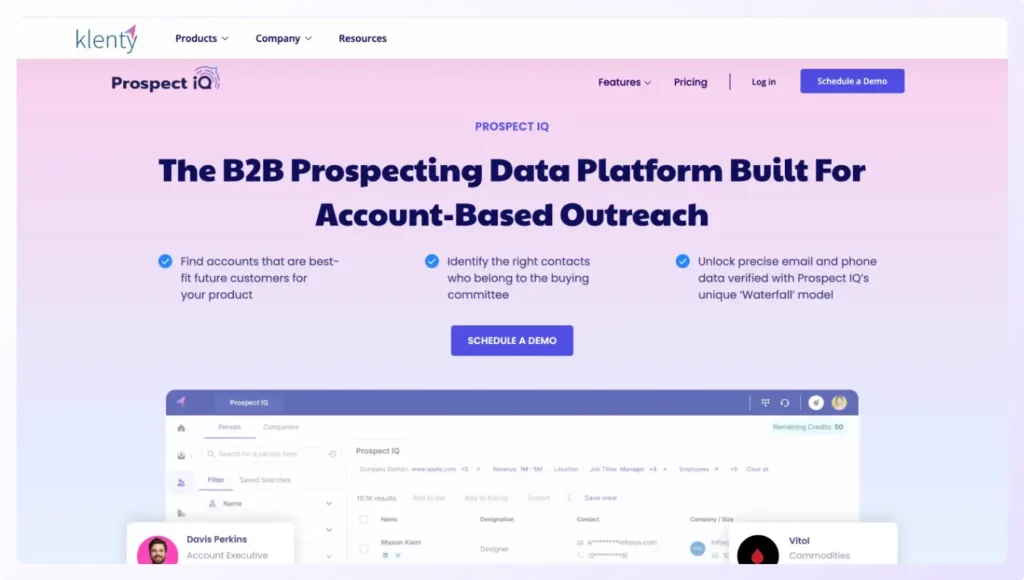
The key highlight? Their unique “Waterfall Model” for lead enrichment screens over 10+ data providers and surfaces the best-fit customer information, leading to high enrichment rates.
Interested in building a high-quality, data-accurate list of your ICPs within minutes? Book a meeting for a tailored demo!
